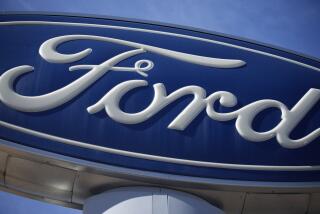Study Finds Threat to the Future of Ford
- Share via
Financially strapped Ford Motor Co. says it will boost introduction of new and revamped cars and trucks. But only by increasing the fuel economy of its vehicles well beyond federal requirements will the automaker avoid going under, a study from a respected academic and former industry insider said Monday.
Ford -- with the worst overall mileage ratings in the industry and the most models to improve -- needs to significantly boost its fuel economy, said Walter McManus, author of the University of Michigan study and director of the transportation institute’s automotive analysis division.
The company has to act now, though, because with costs of $1 billion to $3 billion to significantly revamp existing models and develop new ones, Ford would burn through its $20 billion in available cash by the time it retools its entire model lineup in the next four years, he said.
“If they don’t bring out vehicles that fit the market this time, they don’t have another shot,” said McManus, a former General Motors Corp. economist and chief automotive market forecaster for J.D Power & Associates before joining the university.
While he raised questions about Ford’s future, an article in the trade publication Automotive News suggested that the automaker’s arch-rival, GM, might have a direct role in it by forging an unspecified alliance.
The opportunity to combine forces to pursue fuel-saving technologies could be one reason the two leading American automakers would consider teaming up, as suggested in the article.
The publication, citing unidentified sources, said that talks between Ford and GM, started last month, had since ended and that there was only a slim chance anything would come of them.
Several analysts who reviewed the brief report saw little likelihood of an outright merger. They raised antitrust issues as well as questions about the compatibility of the two automakers’ corporate cultures, their competing dealership networks and their heavily overlapping, truck-heavy model lineups.
“I just don’t know how combining manufacturing processes, or products, would help either one,” said James Sourges, vice president of consulting firm Capgemini’s Detroit-based global automotive practice and leader of its Ford unit.
Industry analyst Tom Libby of J.D. Power’s Power Information Network said talk of an alliance “isn’t a realistic topic.”
“The idea of merging two organizations when each is in such a difficult state just doesn’t seem feasible,” he said of the companies, which have lost significant market share to Asian rivals while posting billions of dollars in losses this year.
Ford announced Friday that it was speeding up plans to shed workers and close factories, following GM in taking such measures.
Analysts said Ford and GM -- which are co-developing fuel-saving six-speed automatic transmissions -- could have a future in other, limited alliances.
“Ford needs some significant help, so who knows?” said David Cole, director of the nonprofit Center for Automotive Research in Ann Arbor, Mich.
Given the companies’ many units -- engines, drivetrains, electronics -- there are areas in which they could collaborate, such as sharing parts, he said. Ford and GM, with fellow Big Three member Chrysler Group, already are partners in a federally supported effort to develop new technology and improve manufacturing.
Ford, which repeatedly has said that everything was on the table as it sought to reverse its fortunes -- including alliances with other auto companies -- declined to comment on the Automotive News report.
GM spokesman Brian Akre did not deny that such talks occurred but said company executives “routinely discuss issues of mutual interest with other automakers.”
“As a policy, we do not confirm or comment publicly on those private discussions, which in many cases never lead anywhere,” he said.
The University of Michigan study issued Monday said automakers could achieve the required fuel-efficiency improvements through widespread application of technologies such as low-friction engine lubricants; six-speed transmissions; variable-valve timing; and systems used now on some GM, Honda Motor Co. and Chrysler models to shut down some cylinders when a vehicle is cruising and doesn’t need full power.
McManus, the study’s author, said he was concerned that struggling American automakers might be tempted to forgo expensive fuel economy improvements if they saw sales of once-profitable pickup trucks and sport utility vehicles revive with gasoline prices that have dropped “for the moment.”
Improved fuel economy that exceeds current regulations “is the key not just to their survival but their success, even if the price of gas goes down,” he said.
If pump prices hover around $3.10 a gallon for regular grade, Ford could attract new customers and increase its net earnings by $1.4 billion a year in 2010 and beyond by delivering a rating of 26.6 miles per gallon for its cars and trucks combined, the report said. That would be a 12% increase from 23.7 mpg today.
With gasoline at $2 a gallon, Ford could still profit, to the tune of about $900 million a year.
Although prices have come down of late, the average for self-serve regular gasoline in California remained at $2.848 a gallon during the week ended Monday and was $2.497 nationally.
But if the U.S. auto companies simply stick to a business-as-usual game plan on the fuel economy front and improve their ratings to merely meet federal requirements through 2010, they could collectively lose as much as $3.6 billion a year, McManus said.
Ford might not grow “if its competitors make better cars with higher fuel economy,” he said, “but what is certain is that Ford cannot capture those sales without higher fuel economy.”
*






